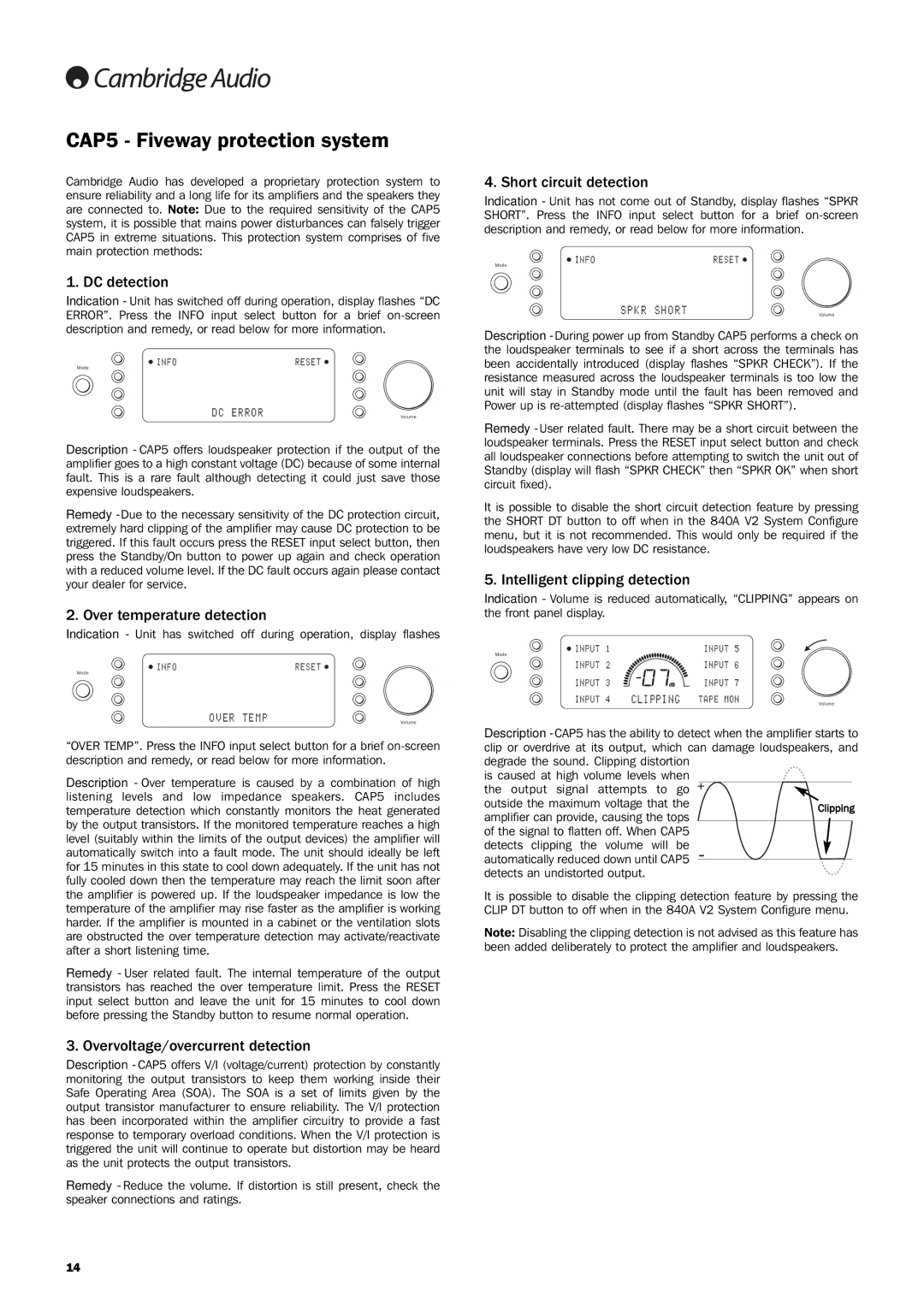CAP5 - Fiveway protection system
Cambridge Audio has developed a proprietary protection system to ensure reliability and a long life for its amplifiers and the speakers they are connected to. Note: Due to the required sensitivity of the CAP5 system, it is possible that mains power disturbances can falsely trigger CAP5 in extreme situations. This protection system comprises of five main protection methods:
1. DC detection
Indication - Unit has switched off during operation, display flashes “DC ERROR”. Press the INFO input select button for a brief on-screen description and remedy, or read below for more information.
Mode
Volume
Description - CAP5 offers loudspeaker protection if the output of the amplifier goes to a high constant voltage (DC) because of some internal fault. This is a rare fault although detecting it could just save those expensive loudspeakers.
Remedy - Due to the necessary sensitivity of the DC protection circuit, extremely hard clipping of the amplifier may cause DC protection to be triggered. If this fault occurs press the RESET input select button, then press the Standby/On button to power up again and check operation with a reduced volume level. If the DC fault occurs again please contact your dealer for service.
2. Over temperature detection
Indication - Unit has switched off during operation, display flashes
Mode
Volume
“OVER TEMP”. Press the INFO input select button for a brief on-screen description and remedy, or read below for more information.
Description - Over temperature is caused by a combination of high listening levels and low impedance speakers. CAP5 includes temperature detection which constantly monitors the heat generated by the output transistors. If the monitored temperature reaches a high level (suitably within the limits of the output devices) the amplifier will automatically switch into a fault mode. The unit should ideally be left for 15 minutes in this state to cool down adequately. If the unit has not fully cooled down then the temperature may reach the limit soon after the amplifier is powered up. If the loudspeaker impedance is low the temperature of the amplifier may rise faster as the amplifier is working harder. If the amplifier is mounted in a cabinet or the ventilation slots are obstructed the over temperature detection may activate/reactivate after a short listening time.
Remedy - User related fault. The internal temperature of the output transistors has reached the over temperature limit. Press the RESET input select button and leave the unit for 15 minutes to cool down before pressing the Standby button to resume normal operation.
3. Overvoltage/overcurrent detection
Description - CAP5 offers V/I (voltage/current) protection by constantly monitoring the output transistors to keep them working inside their Safe Operating Area (SOA). The SOA is a set of limits given by the output transistor manufacturer to ensure reliability. The V/I protection has been incorporated within the amplifier circuitry to provide a fast response to temporary overload conditions. When the V/I protection is triggered the unit will continue to operate but distortion may be heard as the unit protects the output transistors.
Remedy - Reduce the volume. If distortion is still present, check the speaker connections and ratings.
4. Short circuit detection
Indication - Unit has not come out of Standby, display flashes “SPKR SHORT”. Press the INFO input select button for a brief on-screen description and remedy, or read below for more information.
Mode
Volume
Description - During power up from Standby CAP5 performs a check on the loudspeaker terminals to see if a short across the terminals has been accidentally introduced (display flashes “SPKR CHECK”). If the resistance measured across the loudspeaker terminals is too low the unit will stay in Standby mode until the fault has been removed and Power up is re-attempted (display flashes “SPKR SHORT”).
Remedy - User related fault. There may be a short circuit between the loudspeaker terminals. Press the RESET input select button and check all loudspeaker connections before attempting to switch the unit out of Standby (display will flash “SPKR CHECK” then “SPKR OK” when short circuit fixed).
It is possible to disable the short circuit detection feature by pressing the SHORT DT button to off when in the 840A V2 System Configure menu, but it is not recommended. This would only be required if the loudspeakers have very low DC resistance.
5. Intelligent clipping detection
Indication - Volume is reduced automatically, “CLIPPING” appears on the front panel display.
Mode
Volume
Description - CAP5 has the ability to detect when the amplifier starts to
clip or overdrive at its output, which can damage loudspeakers, and |
degrade the sound. Clipping distortion | | | |
is caused at high volume levels when | | | |
the output signal attempts to go | | | |
outside the maximum voltage that the | | Clipping |
amplifier can provide, causing the tops | |
| | |
of the signal to flatten off. When CAP5 | | | |
detects clipping the volume will be | | | |
automatically reduced down until CAP5 | | | |
| | |
| | |
detects an undistorted output. | | | |
It is possible to disable the clipping detection feature by pressing the CLIP DT button to off when in the 840A V2 System Configure menu.
Note: Disabling the clipping detection is not advised as this feature has been added deliberately to protect the amplifier and loudspeakers.

